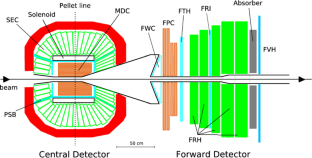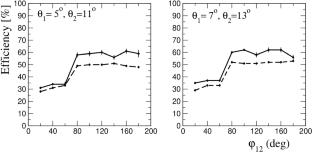dp 分裂反应中的三核子动力学实验研究
IF 1.7
4区 物理与天体物理
Q2 PHYSICS, MULTIDISCIPLINARY
引用次数: 0
摘要
目前正在进行数据分析,目的是确定在 300 和 400 MeV 之间的四种氘核束能量下 \(^{1}\)H(d, pp)n 分裂反应的差分截面。这些数据是在 COSY-Jülich 使用 WASA 探测器测量的。这项工作的重点是 380 兆电子伏特(190 兆电子伏特/核子)的光束能量。在前向探测器上记录的质子-质子重合数据集在密集的运动学变量网格上进行分析。分析的主要步骤之一是效率研究。讨论了它们对最终结果准确性的影响。本文章由计算机程序翻译,如有差异,请以英文原文为准。


Experimental Study of Three-Nucleon Dynamics in the dp Breakup Reaction
The data analysis is in progress with the aim to determine the differential cross sections for the \(^{1}\)H(d, pp)n breakup reaction at four deuteron beam energies between 300 and 400 MeV. The data have been measured with the use of the WASA detector at COSY-Jülich. This work is focused on the beam energy of 380 MeV (190 MeV/nucleon). Set of proton-proton coincidences registered at the Forward Detector is analysed on a dense grid of kinematic variables. The one of the main steps of the analysis is efficiency study. Their impact on the final accuracy of the result is discussed.
求助全文
通过发布文献求助,成功后即可免费获取论文全文。
去求助
来源期刊

Few-Body Systems
物理-物理:综合
CiteScore
2.90
自引率
18.80%
发文量
64
审稿时长
6-12 weeks
期刊介绍:
The journal Few-Body Systems presents original research work – experimental, theoretical and computational – investigating the behavior of any classical or quantum system consisting of a small number of well-defined constituent structures. The focus is on the research methods, properties, and results characteristic of few-body systems. Examples of few-body systems range from few-quark states, light nuclear and hadronic systems; few-electron atomic systems and small molecules; and specific systems in condensed matter and surface physics (such as quantum dots and highly correlated trapped systems), up to and including large-scale celestial structures.
Systems for which an equivalent one-body description is available or can be designed, and large systems for which specific many-body methods are needed are outside the scope of the journal.
The journal is devoted to the publication of all aspects of few-body systems research and applications. While concentrating on few-body systems well-suited to rigorous solutions, the journal also encourages interdisciplinary contributions that foster common approaches and insights, introduce and benchmark the use of novel tools (e.g. machine learning) and develop relevant applications (e.g. few-body aspects in quantum technologies).
 求助内容:
求助内容: 应助结果提醒方式:
应助结果提醒方式:


